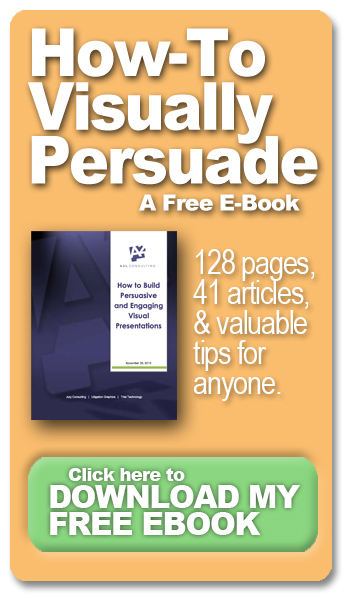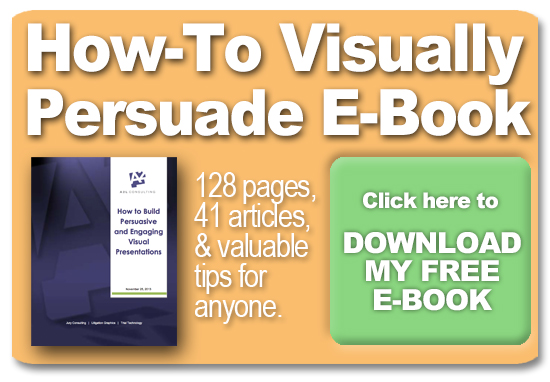 by Ken Lopez
by Ken Lopez
Founder/CEO
A2L Consulting
In the last 15 years, businesspeople are increasingly being called upon to persuade visually. Whether it is a corporate PowerPoint, a political infographic or even a well-formatted Excel spreadsheet, visual persuasion is now part of what we are all expected to do — just like writing a business letter or running a meeting.
A2L is well known for its work developing persuasive presentations for the courtroom. However, for the past 18 years, A2L has quietly been helping non-lawyers and lawyers presenting outside the courtroom to develop stunning and persuasive presentations. These projects have included supporting the energy and aviation industries in their lobbying efforts, creating marketing designs for large Internet firms, developing pitch presentations for our legal clientele, creating animations for non-courtroom use and even developing high-profile web sites.
We have learned and taught others a great deal about developing persuasive presentations. It is something that our firm does every single working day of the year. Indeed, it turns out that the same lessons that apply to lawyers hoping to persuade a jury apply just as well to other audiences who need to be persuaded - whether they are a prospective client, a skeptical neighborhood group or potential voters.
We have put together a new e-book entitled “How to Build Persuasive and Engaging Visual Presentations.” We think the book will be useful for anyone who is called upon make a visual presentation, be it simple or complex.
This book compiles lessons and best practices from our experiences over nearly two decades, together with other resources, many of them gleaned from the research of leading scholars who have studied how the human mind receives, processes and stores information.
Among the topics covered in this book are “Persuasive Graphics: How Pictures Are Increasingly Influencing You,” “6 Studies That Support Litigation Graphics in Courtroom Presentations,” “Demonstrative Evidence Tricks and Cheats to Watch Out For,” “In Trial Presentation a Camel is a Horse Designed by a Committee,” “12 Reasons Bullet Points Are Bad in Trial Graphics or Anywhere,” “Explaining a Complicated Process Using Trial Graphics,” “The 12 Worst PowerPoint Mistakes Litigators Make,” “Information Design and Litigation Graphics,” “Teaching Science to a Jury: A Trial Consulting Challenge,” “Litigation Graphics: Psychology and Color Meaning,” and “Legal Animation: Learn About the Four Types Used in the Courtroom.”
I hope this book helps you develop effective, exciting and persuasive visual presentations. You can download this valuable new e-book here.






Leave a Comment